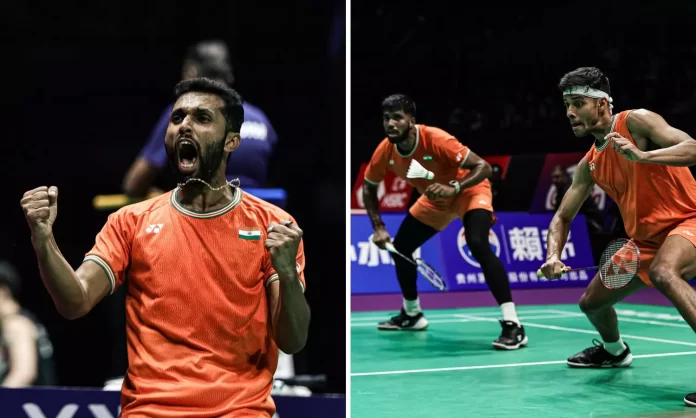The enchantment of gold-built air castles has been broken. With the construction of a scaffolding around Satwiksairaj Rankireddy and Chirag Shetty’s Olympic 2024 building, the physical repairs may now start in earnest.
When they won the Asian Games last winter, the Paris gold seemed so close. Now, it seems far away. And in the interim, that might be the best thing that could happen to them.
Over the past four months, Satwik-Chirag has dropped to No. 3 in the world rankings after losing three event finals and giving up their No. 1 spot. India’s Thomas Cup reign came to an end on Friday when they lost 3-1 to China in the quarterfinals, including a 15-21, 21-11, and 12-21 loss in the ace doubles against current World No. 1s Liang Weikeng and Wang Chang. To claim that a much-needed market correction of their fortunes was under way would be incorrect, as they are not stocks but rather perfectly sensible, sensitive persons. However, these shocks will guarantee that their skills are strengthened and updated in time for the Olympics, as their skill set is still incomplete at its core.
Similar to how PV Sindhu’s dramatic defeat at the 2017 Glasgow World Championships forced her to develop into a more well-rounded player for 2019, these reverses will only encourage Satwik-Chirag to seal the holes, search for loose wiring, and troubleshoot the cracks rather than applying a quick coat of gold aspirational paint. They will no longer believe that they are in control and that they just need to show up in Paris for everything to work out.
Their problems against left-right partnerships at the previous World Championships were shattered when the Danes, Anders Rasmussen and Kim Astrup, gave them a severe surprise. However, the Chengdu Thomas Cup was a complete travesty, with the pairings so disorganised in the two sets they lost that they frequently misplayed the same shuttles and were out of position on the same side of the court. It was startling since, on most days, they take division of labour and territory defence so for granted. It wasn’t a lack of effort, but rather a desperate desire to make things work.
To further confuse matters, the pair performed the second set as though there were no issues at all. The Chinese variety of serves appeared to have a devil’s snare in the opening set, but good assault, long rallies, and giving back in kind for all the receiving suffering were evident.
The main cause of their problems is that, having lost to the Chinese five times out of seven, including important finals, the Indians have established themselves as formidable opponents just before Paris. The key to winning doubles badminton is controlling the first four strokes. The serve and return have become tricky since different pairings, most notably Chinese with Liang Weikeng, mix up their serve variants in an unsettling way.
In Chirag’s mind, the tumble serve—which often spins in different directions—has taken on the demonic qualities of a boggart, even though Satwik occasionally finds it difficult to read. What happened on Friday was blithering and blundering along the court as has never been witnessed in this couple once the return becomes a tentative scramble. The Chinese coaches have worked extra hard to make every moment miserable for the Indians knowing they will compete for gold as well. They battled against the Indonesian flat game of Bagas Maulana-Muhammad Shohibul Fikri on Thursday as well.
That day the Indians were bewildered and bogged down by the serves. “In the first game, they held the net and continued to come in fiercely. It seemed as though, “Oh, you better get ready.” We dropped two points in five seconds. It isn’t about holding rally after rally. It was 11-4 in ten minutes. How could I play more rallies as I wanted to? Each time, that occurred, Satwik subsequently remarked.
Chirag looked composed and pumped up when he bought himself some room to hit cross. However, he was quiet when attacking for the most part, and his poise is crucial in this combination. While Chirag mopes and feels guilty about himself, Satwik can shrug off point losses since he has all the countermeasures for the flat parallel game. On that day, their defences both withered, but their inability to unshackle and control play made the serve-receiving ailment disastrous. A hint of a side drift compounded the misery caused by the rotating difficulties.
The Chinese are known for their quick and sharp exchanges, which their coaches applauded with consternation. These will force the Indians into a meeting with their coaches. The Malaysians and the Koreans, Seo-Kang, offer another challenge of lengthy, cerebral rallies that resemble chess. It is anticipated that Mathias Boe will work with them for extended periods of time to devise solutions for these many sharp edges.
Men’s doubles is so good that Satwik-Chirag may find themselves playing four different kinds of matches in four days. They will need to go above and beyond what they typically do. “The first four strokes are more important than the rallies. We won competitions when we performed that well. We won’t doubt ourselves because the competition has gone well. However, a slight lack of confidence. We still have time, Satwik said.































